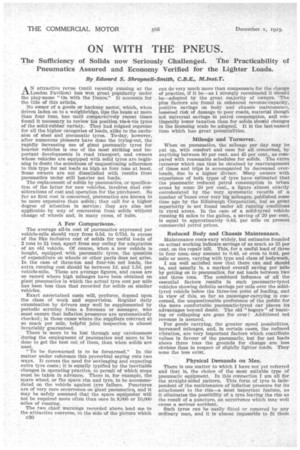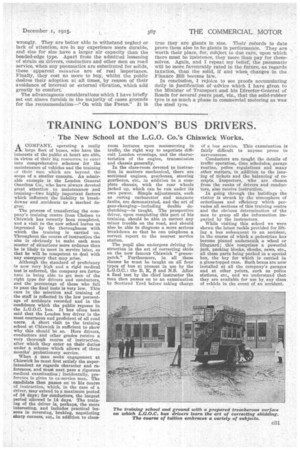ON WITH THE PNEUS.
Page 14

Page 15

If you've noticed an error in this article please click here to report it so we can fix it.
The Sufficiency of Solids now Seriously Challenged. The Practicability of Pneumatics Assured and Economy Verified for the Lighter Loads.
By Edward S. Shrapnel-Smith, C.B.E., 111.1nst.2'.
AN attractive revue (until recently running at the London Pavilion) has won great popularity under the play-name "On with the Dance." It accounts for the title of this article,
No owner of a goods or hackney motor, which, when driven laden on to a weighbridge, tips the beam at more than four tons, has until comparatively recent times found it necessary to review his position vis-k-vis tyres of the solid-rubber variety. They had reigned supreme for all the higher categories of loads, alike to the exclusion of steel and pneumatic tyres. To-day, however, after numerous pioneers have done the trying-out, the rapidly increasing use of giant pneumatic tyres for heavier vehicles is one of the most striking and important developments in road transport, and owners whose vehicles are equipped with solid tyres are beginning to doubt the soundness of unquestioning adherence to this type for net loads as high as four tons at least. Some owners are not dissatisfied with results from pneumatics under still heavier net loads.
The replacement of solids by pneumatics, or specification of the latter for new vehicles, involves dual considerations of cost and operation for the purchaser. So far as first cost is concerned, pneumatics are known to be more expensive than solids; they call for a higher degree of attention in service; they are also net applicableby way of conversion from solids without change of wheels and, in many eases, of hubs.
A Few Comparisons.
The average all-in cost of pneumatics expressed per vehicle-mile should vary from 0.5d. to 0.75d. in excess of the like inclusive cost of solids for useful loads of 2 tons to 2i tons, apart from any outlay for adaptation of an old vehicle. Of course, when a new vehicle is bought, equipped with pneumatic tyres, the question of expenditure on wheels or other parts does not arise. In the case of three-ton and four-ton net loads, the extra running cost should be between Id. and 1.5d, per vehicle-mile. These are average figures, and cases are on record where high mileages have been obtained on giant pneumatics in which the actual tyre cost per mile has been less than that recorded for solids on similar vehicles.
Exact ascertained costs will, perforce, depend upon the class of work and supervision. Regular daily examination by drivers may well be supplemented by periodic scrutiny from a foreman or manager, who must ensure that inflation pressures are systematically checked; in those cases where the suppliers Contract at so much per mile, helpful joint inspection is almost invariably guaranteed. '
There is more to be lost through any carelessness during the employment of pneumatics and more to be done to get the best out of them, than when solids are used.
"To be forewarned is to be forearmed." In the matter under reference this proverbial saying cuts two ways. It covers the need for envisaging and expecting extra tyre costs; it is equally typified by the inevitable changes in operating practice, to permit of which steps must be taken in advance. There is, for example, the spare wheel, or the spare rim and tyre, to be accommodated on the vehicle against tyre failure. Punctures are of very rare occurrence on giant pneumatics, and it may be safely assumed that the spare equipm4nt will not be required more often than once in 8,000 or 10,000 miles of running.
The two chief warnings recorded above lead me to the attractive converse, to the side of the picture which c30
can do very much more than compensate for the change of practice, if it be—as I strongly recommend it should be—adopted bY the great majority of owners. The pins factors are found in enhanced revenue-capacity, positive savings on body and chassis maintenance, lessened risk of damage to poor roads, material though not universal savings in petrol consumption, au a contingently lower taxation than for solids should changes in the licensing scale be adopted. It is the last-named item which has great potentialities.
Mileage and Turnover.
When on pneumatics, the mileage per day may be put up, with comfort and ease for all concerned, by anything between 30 per cent. and 45 per cent., as compared with reasonable schedules for solids. The extra turnover which can thus be obtained by rearrangement of times and trips is accompanied by decreased overheads, due to a higher divisor. Many owners with experience of both types of tyre have eStimated that the pneumatic reduced petrol consumption in urban areas by some 20 per cent., a figure almost exactly corroborated by the very systematic records of a number of buses over very big mileages, published some time ago by the Edinburgh Corporation, but so great superiority is not found under all running conditions in rural areas. In the case of a solid-tyred vehicle running 6i miles to the gallon, a saving of 20 per cent is equal to approximately 0.4d. per mile on present commercial petrol prices.
Reduced Body and Chassis Maintenance.
Maintenance costs vary widely, but estimates founded on actual working indicate savings of as much as 25 per cent. on the repair bill. This, for a useful load of three to four tons,--may amount to 0.4d. or even to 0.6d. per mile or more, varying with type and class of bodywork.
I am well satisfied now that there can and should be, and ustially is, a marked overall saving per mile by getting on to pneumatics, for net loads between two and three tons. The combined influence of all the essential factors results in such pneumatic-tyred vehicles showing definite savings per mile over the solidtyred vehicle below the three-ton point of loading, and in view of this, so far as passenger-carrying Is concerned, the unquestionable preference of the public for the more comfortable pneumatic-tyrul car places its advantages beyond doubt. The old " bogeys " of bursting or collapsing are gone for ever Additional net revenue is assured.
For goods carrying, the greater speed possibilities, increased mileages, and, in certain cases, the reduced vibration, are very important factors which contribute values in favour of the pneumatic, but for net loads above three tons the grounds for change are less obvious than in respect of slightly lighter loads. They none the less exist.
Physical Demands on Men.
There is one matter to which I have not-yet referred and that is, the choice of the most suitable type of pneumatic equipment. ill this connection I am all for the straight-sided pattern. This form of tyre is independent of the maintenance of inflation pressure for its attachment to the rim—a most important feature, as it eliminates the possibility of a tyre leaving the rim as the result of a puncture, an occurrence which may well cause a serious accident.
Such tyres can be easily fitted or removed by any Ordinary man, and it is almost impossible to fit them
wrongly. They are better able to withstand neglect or lack of attention, are in my experience more durable, and size for size have a larger air capacity than the beaded-edge type. Apart from the admitted lessening of strain on drivers, conductors and other men on road service, when any pneumatics are substituted for solids, these apparent minutio are of real importance. Finally, they cost no more to buy, whilst the public degires their adoption at all times, by reason of their avoidance of internal or external vibration, which add greatly to comfort. The advantageous considerations which I have briefly set out above furnish in the majority of cases grounds for the recommendation---" On with the Diens." It is
true they are giants in size. Their records to date prove them also to be giants in performance. They are worth their place, for, subject to due care, upon which there must he insistence, they more than pay for themselves. Again, and I repeat my belief, the pneumatic will be more favourably rated in the future, as regards taxation, than the solid, if and when changes in the Finance Bill become law.
In conclusion, I rejoice to see proofs accumulating daily in justification of 'advice which I have given to the Minister of Transport and his Director-General of Roads for several years past, viz., that the solid-rubber tyre is as much a phase in commercial motoring as was the steel tyre.






























